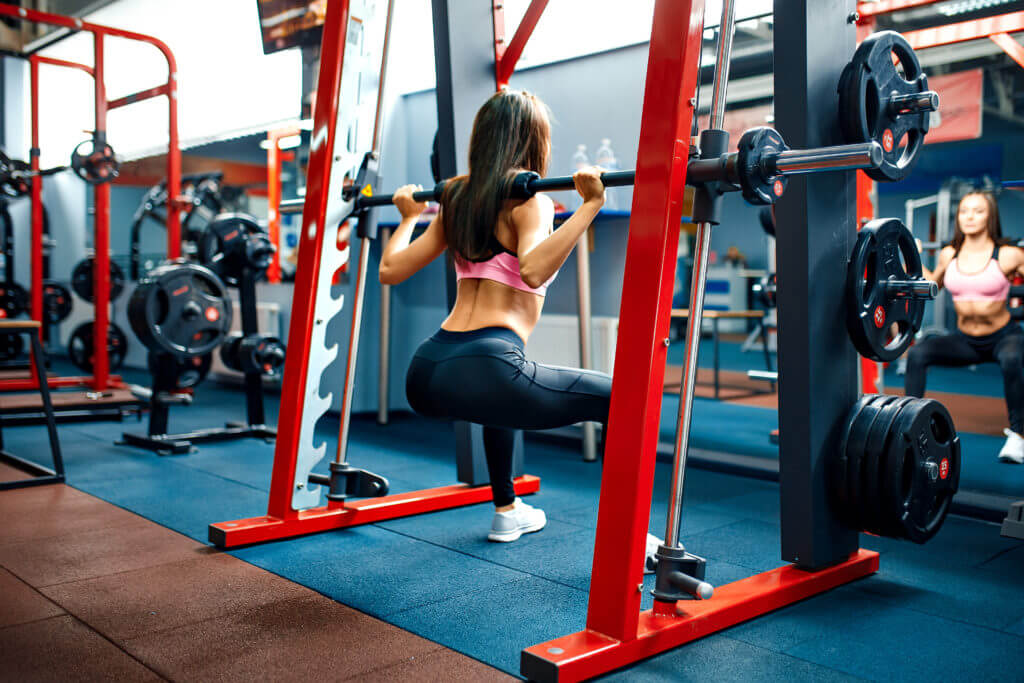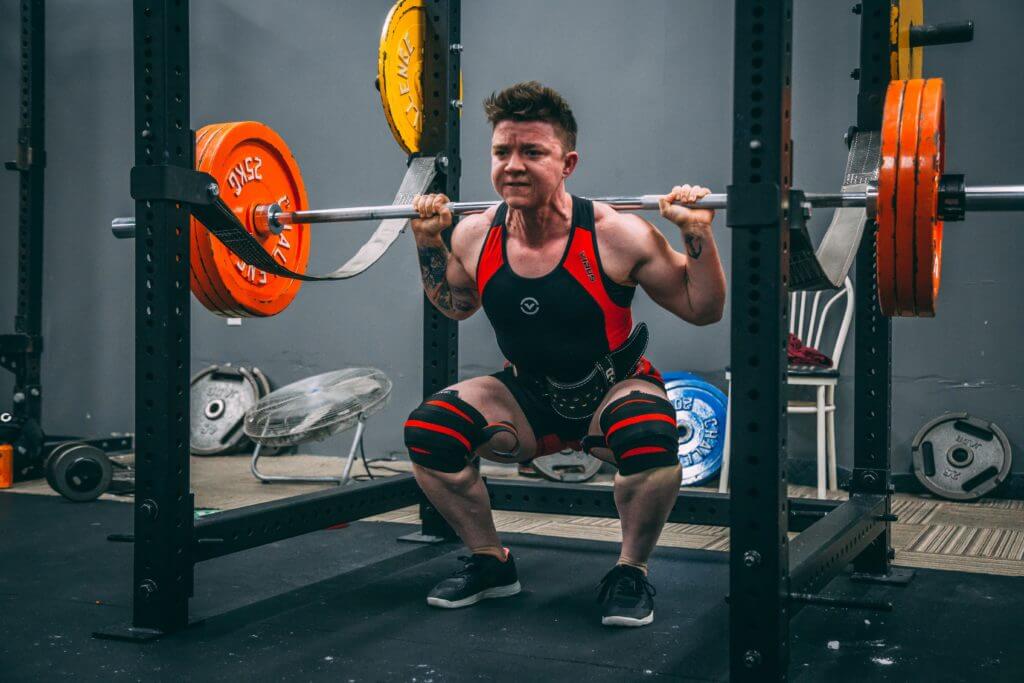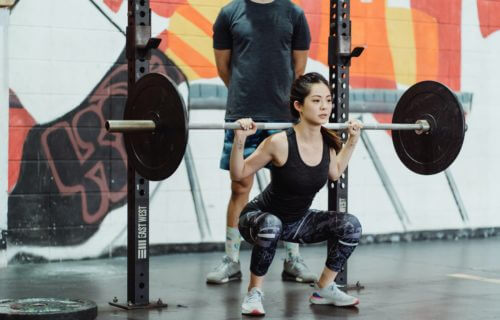Ah, the gym-goer debate: which is the superior way to squat, with a barbell in a squat rack or in a Smith machine? Study Finds scrubbed the top sites to find your answer; but before we share what the experts had to say, let us clarify the differences between these two types of squats that divide people so.
A Smith machine closely resembles a squat rack except that it has a fixed barbell that is typically lighter than a standard barbell. Though more companies today do offer the option of a standard 45-pound barbell. Older Smith machines only allow for a vertical bar path, but newer versions also allow for horizontal movement. Even though a squat in today’s Smith machines do more closely mimic a free weight (barbell) squat, it’s still not exact. The fixed bar doesn’t allow for the body to follow its natural pattern into and out of a squat. For many though, that fixed bar is a draw because they feel it’s a safer way to squat. Another argument for the Smith machine is that people often feel they’re better able to isolate specific muscles.

With a barbell squat, the bar will not be fixed to the rack. This means that when you’re squatting you fully control the bar and the weight. This also means that if you lean too far forward or back, you can fall. There is no fixed bar to save you. Those that argue for barbell squats do so mostly because the mechanics are that of the body’s true squat pattern. Without the fixed bar, core muscles and smaller stabilizer muscles must act to help you balance.
Okay, so with a Smith machine squat you get the safety of a fixed barbell and the potential to better isolate certain muscles, but you may be forced into an unnatural movement pattern. With a barbell squat your body can follow its natural patterns and it may have to work harder while doing so.
So which is it, the barbell squat or Smith machine squat? Enter the experts. And of course, we want to know which type of squat you prefer. Are you a fan of the Smith machine squat? The barbell squat? Both? Let us know in the comments below!
The List: Which Do Experts Choose, Smith Machine Squats or Barbell Squats?
1. Muscle & Fitness: Both!
“One major difference between the barbell squat and the Smith machine squat is how far you can bring your feet in front. With the barbell, there is only one position—feet directly under the bar. In contrast, the Smith machine follows a fixed path, thereby removing the need to balance it, so you can bring your feet out to various distances,” writes Muscle & Fitness. The older Smith machines with a vertical-only bar path do allow you to manipulate foot placement to extremes which can help target different muscles whereas this is not possible while performing a barbell squat.
Muscle & Fitness also notes that the farther in front of the bar the foot placement the more emphasis on glutes and hamstrings and less on quads. The opposite happens with the feet placed directly under the bar such as in a barbell squat. In that instance the quads take the load and not so much the hamstrings and glutes.
Also noteworthy is a study that M&F cited where max strength in a group of seasoned lifters was about 5% higher on their Smith machine squat than it was on their barbell squat. The researchers suggested that this may have been because less balance is needed in a Smith machine thus allowing for more focused effort in driving straight up into the bar.
And so, Muscle & Fitness recommends that you “alternate between these versions of the squat from workout to workout, or perform barbell squats first in your leg workout and follow them with the Smith machine version after barbell squats have fatigued your stabilizers.” Rather than choose one, M&F takes the approach of using the best of both worlds. Following their advice will allow you to add more tools to your gym tool bag.
2. Inspire US: Both!
“Though it is well established that the barbell squat activates the majority of lower body muscle groups to a far more intense extent than the smith machine squat, the latter is still capable of exemplifying the hamstrings and glutes muscle groups due to its altered form,” writes Inspire US. Just as Muscle & Fitness noted, with manipulation of foot placement, more emphases can be placed on the hamstrings and glutes in a smith machine by bringing the feet forward of the bar. Still, Inspire US does emphasize the fact of there being more lower body muscle activation with a barbell squat.
Okay, we know about quad, glute, and hamstring activation, but what about safety? “Though both exercises are considerably safe and present low risks of injury when performed in an appropriate manner, it is the smith machine squat that is least likely to result in significant injury,” they explains. This is because of the fixed bar and built-in safety mechanisms of the Smith machine.
Inspire US also writes, “as such, if the exerciser is of novice experience, uncomfortable with the form of the barbell squat, or an athlete recovering from an injury; the smith machine squat is the safer of the two choices.” Special circumstances such as a person that is new to squatting or someone that has physical limitations, or an injury, make the Smith machine a good option.
Much like Muscle & Fitness, Inspire US finds both squats can be beneficial. “Though this article focuses primarily on which exercise is better than the other, many higher-level exercisers and athletes find that they can best benefit by combining the two exercises in a manner that reduces stabilizer muscle group fatigue and pressure on the joints – all while still retaining an intense training stimulus.” When in doubt, train both types of squats!
3. Lift Big Eat Big: Barbell squat — but Smith machine can still be great
Lift Big Eat Big wastes no time getting to the heart of the debate: “There are two sides to the Smith machine squat vs. barbell squat argument. One states that the Smith machine is dangerous because it locks you into an unnatural movement while the other states it is safer because you are on a guided rack.” It seems that much of the debate is based on perspective and opinion for the average gym-goer, but there is still the research indicating that barbell squats produce more overall muscle activation.
“When we dive deeper into muscle activation, barbell squats elicit 34% higher muscle activation of the calf muscles, 26% higher activation from the outer hamstring (biceps femoris), and 49% greater activation from the inner quadricep (vastus medialis, aka VMO) compared to Smith machine squats,” their post explains. “There was also a trend for the outer quadricep (vastus lateralis) to have 25% greater activation during barbell squats.”

But does Lift Big Eat Big make any room for the Smith machine? “Now, is there a time and place for the Smith machine in your training? Potentially. One reason many use the Smith machine is to train the legs without placing more stress on the lower back.” Barbell squats can force more trunk flexion (forward torso lean) than the Smith machine. The ability to place the feet further in front of the body while using a Smith machine allows the torso to remain more upright during the squat as opposed to the forward hinge created during a barbell squat. The upright trunk helps to alleviate much of the stress that would otherwise be placed on the lower back in a hinged position.
“It’s not inherently bad to squat in a Smith machine. If you are serious about strength and strength sports, you should either avoid it or use it sparingly if you are trying to target certain muscle groups while squatting for hypertrophy purposes,” they add. If you are a competitive powerlifter, then you practice the movement that you will face on meet day: the barbell squat.
But, “if you are on the bodybuilding side, the Smith machine can be a tool to target muscle groups based on your foot placement,” writes Lift Big Eat Big. If you’re pursuing muscular hypertrophy, a Smith machine might be a good tool for you.
4. Scientists themselves: It depends on the goal
What say scientists? In a randomized controlled trial, researchers at the University of Saskatchewan’s College of Kinesiology, used electromyography (EMG) to compare leg and trunk muscle activation in the Smith machine and barbell squat. Once again, we see a large difference in muscle activation.
In their study, eight participants performed one set of eight repetitions of each squat with a minimum of three days’ rest between. The result? The EMG reading averaged over all muscle groups (legs and trunk) was 43% higher in the barbell squat. Another clear victory for the barbell squat when it comes to overall muscle activation.
“The free weight squat may be more beneficial than the Smith machine squat for individuals who are looking to strengthen plantar flexors, knee flexors, and knee extensors,” write the researchers.
Once again it comes down to specifics: if you are training for specific adaptations, one type of squat may be better for you. Keep in mind, the researchers did not argue for or against either type of squat, they merely compared muscle activation. By no means does their article argue for one squat or the other.
5. Set For Set: Both!
Set For Set raises a great point: “The first thing to note is that a smith machine squat is not like a free weight squat. Yes, you are squatting, but the form must be different due to the smith machine having a fixed bar path.” Though both are squats, you will want to approach them with a different mindset and a different set of expectations due to the distinctions in form, technique, and results.
Speaking about the forward foot position on a Smith squat, their comparison notes that “you can think of the smith machine squat like a hybrid between a free barbell squat and a hack squat.” Much of the argument stems from people trying to compare the two squats as apple to apple, when in fact it may be apple to orange.
And so, to answer the question of whether or not you should do Smith machine squats, Set For Set concludes: “Yes, they are great to do in addition to free weight barbell squats. A lot of average lifters hate on the Smith machine, but ask any pro and they will tell you it has its place, even with squats. It’s a good accessory exercise for the quads, just like hack squats or leg presses are.”
Yet again we find good cause to incorporate both types of squats into a strength training routine.
The Verdict: Use Both
After reviewing research and commentary from experts, the verdict is clear: there is a place for both types of squats. Yes, the barbell squat may stimulate more overall muscle activation, but the Smith machine can still be used to better isolate some of those muscles. For beginners not comfortable with a barbell squat, the Smith machine offers the fixed bar which may bring peace of mind. The barbell squat may allow for more range of motion, but the Smith machine allows for more variety in both foot placement and muscles targeted.
So, if you have access to both types of squats, there is no harm in taking advantage of both. If you prefer one over the other that is also okay. The experts make room for both the Smith machine squat and barbell squat in the world of strength training.
You might also be interested in:
- Best Squat Racks
- Best Ways To Do Push-Ups
- Best Jump Ropes
- Best Home Gyms
- Best Dumbbells for Home Gyms
Sources:
Note: This article was not paid for nor sponsored. StudyFinds is not connected to nor partnered with any of the brands mentioned. Listed prices for products may correspond to when article was published.
